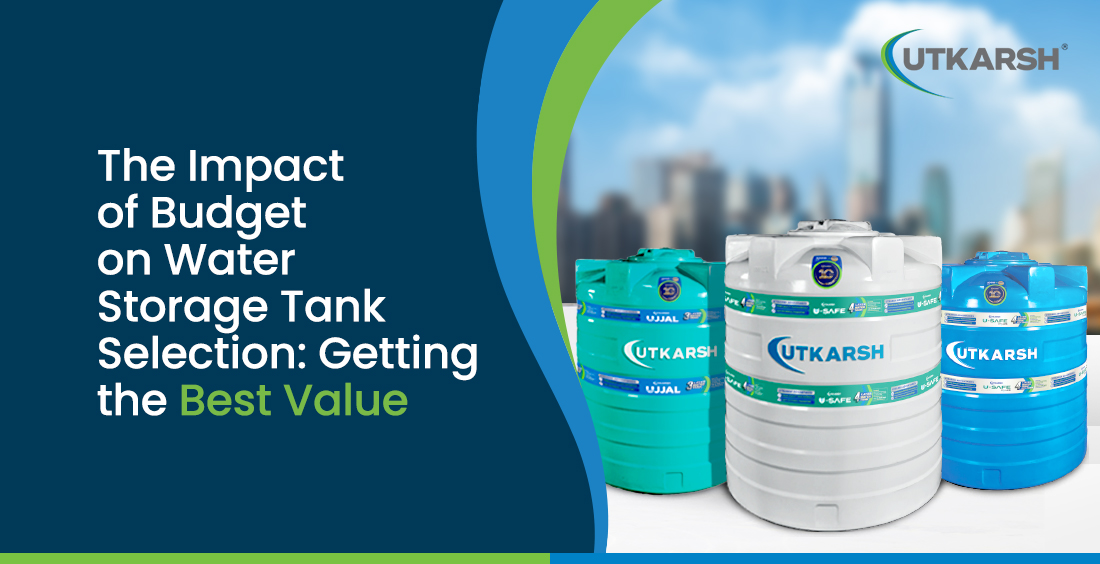The impact of budget on water storage tank selection: Getting the best value

When selecting a water storage tank in India, the budget plays a crucial role in determining the best option. Water storage solutions are essential for many households, industries, and agricultural operations due to varying water supply patterns, water shortages, and the erratic nature of monsoons. In this article, we explore how your budget impacts the selection of water storage tanks:
1. Initial Purchase Costs
The initial cost of purchasing a water storage tank is often the most visible part of the investment. This includes the cost of the tank itself, delivery, installation, and any immediate accessories required for use. These initial costs are highly influenced by the type, size, and material of the tank, and the installation environment.
- Size and Capacity:
- Material and Type of Tank:
One of the primary factors determining the cost of a water tank is its size and capacity. Larger tanks, naturally, require more material, more robust construction, and possibly even a stronger foundation, all of which increase the cost. For example, in urban areas where water supply can be inconsistent, a larger tank of 5,000 to 10,000 litres may be necessary to store enough water for daily use during times of scarcity. These tanks will be more expensive than a smaller 1,000-litre tank, commonly used in more water-abundant areas.
However, investing in a larger tank can offer long-term savings. For instance, a household that instals a larger tank during the monsoon season can store enough rainwater to meet its needs during the dry summer months, reducing dependency on tanker water, which can be expensive. In rural India, larger tanks are also often preferred, as they allow farmers to store water for irrigation and cattle, ensuring their livelihood during droughts.
The type of material used to construct the tank also plays a significant role in determining the initial cost. In India, plastic (PVC) tanks are the most popular due to their affordability, durability, and ease of installation. Steel tanks are another option, particularly in industrial settings where the storage of large volumes of water is required. However, steel tanks come with a much higher upfront cost and may require corrosion protection treatments, especially in coastal regions of India.
2. Installation Costs
The cost of installing a water tank in India varies significantly based on factors such as the type of tank, the location of the installation, and the condition of the site. While the tank itself may be affordable, the installation process can sometimes add unexpected costs.
- Site Preparation:
- Labour and Transportation:
In many parts of India, especially in rural areas, the condition of the site can impact installation costs. A flat, stable site will incur minimal costs for preparation. However, in hilly areas or in places with rocky terrain such as Rajasthan, additional groundwork may be required, which can add significantly to the overall cost.
Labour costs in India can vary depending on the region. In metro cities like Delhi, Mumbai, or Bengaluru, labour costs tend to be higher compared to smaller towns or rural areas. For example, while installing a small plastic tank might only require the help of a few local workers, installing a larger or underground concrete tank may require specialised labour and equipment, such as cranes, which can increase costs.
Transportation is another factor to consider, especially if you live in a remote location. Larger tanks, particularly concrete or steel ones, can be expensive to transport due to their size and weight. For rural areas with poor road access, transportation costs can be even higher.
3. Long-term Ownership Costs
While the initial cost of purchasing and installing a water tank is important, it’s equally essential to consider the long-term expenses associated with maintaining and operating the tank. These costs can include maintenance, operational expenses, and potential replacement costs, all of which can have a significant impact on your overall budget.
- Operational Costs:
- Replacement Costs:
If your water tank system includes pumps, filters, or other water purification equipment, it’s important to factor in the operational costs of running these systems. In many parts of India, particularly urban areas, electric pumps are required to fill rooftop tanks from underground borewells or municipal supplies. The electricity costs associated with running these pumps can add up over time, especially during the summer when water usage is higher.
Over time, exposure to sunlight and other environmental factors can cause tanks to degrade, making replacement necessary. Planning for future replacement costs is important, especially in areas where access to clean water is critical and a reliable storage solution is essential.
Looking for high-quality water tanks for sale?
Explore our water storage tanks for sale. Made from 100% virgin, food-grade materials, our plastic water tanks ensure the safe and hygienic storage of water. The unique six-shoulder design offers exceptional compressive strength and effectively prevents the growth of fungus, bacteria, algae, and resists corrosion. With complete UV protection, our tanks are built to withstand all weather conditions, providing long-lasting durability. For added safety and convenience, they feature threaded lids, making installation quick and easy. Manufactured using the advanced roto-moulding process, our water tanks meet stringent Indian and international quality standards.